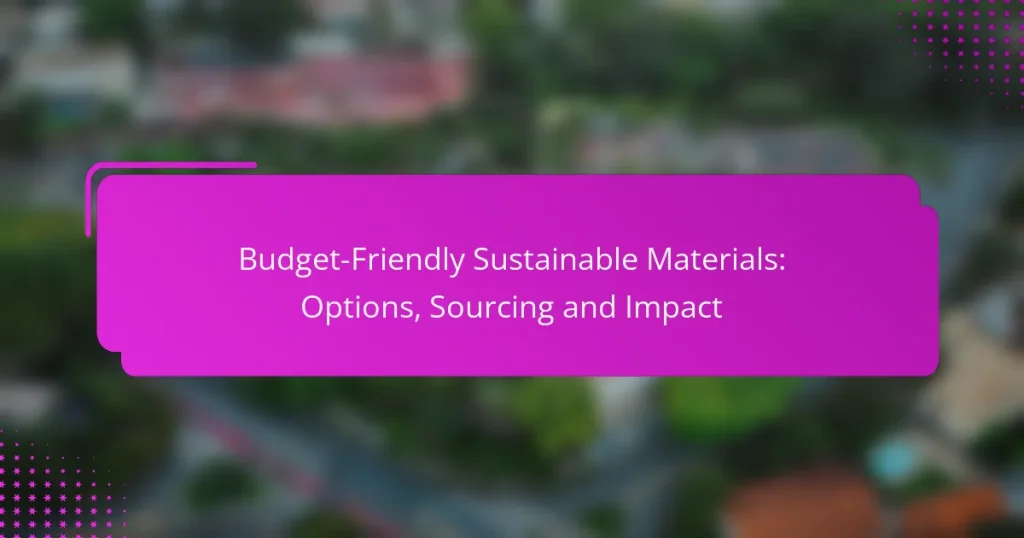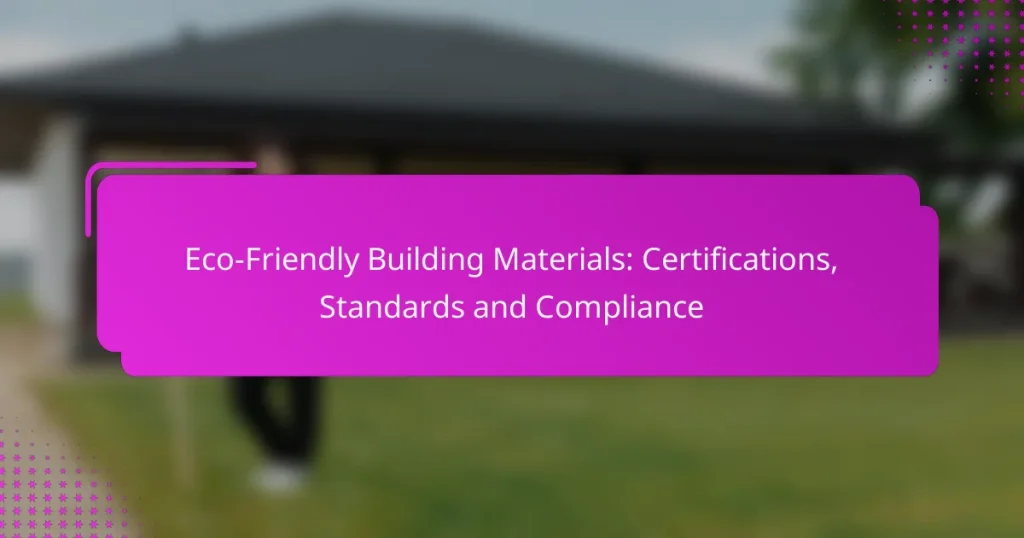Sustainable home design consulting emphasizes the importance of using eco-friendly materials to create a healthier and more efficient living environment. By selecting renewable, recyclable, and responsibly sourced options, homeowners can significantly reduce their environmental impact while enhancing the functionality and longevity of their spaces. Incorporating materials like bamboo flooring, reclaimed wood, and low-VOC paints not only benefits the planet but also improves the overall quality of life within the home.
Budget-Friendly Sustainable Materials: Options, Sourcing and Impact
Sustainable Flooring Options: Durability, Aesthetics and Cost
Recycled vs. New Materials: Which Is Better and When to Use
Eco-Friendly Building Materials: Certifications, Standards and Compliance
Eco-Friendly Insulation Materials: Types, Performance and Cost Savings
Eco-Friendly Building Materials: Types, Benefits and Applications
What are the best eco-friendly materials for sustainable home design?
The best eco-friendly materials for sustainable home design include bamboo flooring, recycled steel, reclaimed wood, low-VOC paints, and natural insulation materials. These options not only reduce environmental impact but also enhance the overall sustainability and energy efficiency of your home.
Bamboo flooring
Bamboo flooring is a popular choice due to its rapid growth and renewability, making it a sustainable alternative to traditional hardwoods. It is durable, moisture-resistant, and can be harvested without killing the plant, allowing for continued growth.
When selecting bamboo flooring, look for products that are certified by organizations like the Forest Stewardship Council (FSC) to ensure responsible sourcing. Consider the finish as well; opting for low-VOC finishes can further enhance its eco-friendliness.
Recycled steel
Recycled steel is an excellent option for structural components, roofing, and siding. Using recycled steel reduces the need for new raw materials and minimizes energy consumption during production. It is highly durable and can withstand harsh weather conditions.
When incorporating recycled steel, check for certifications that indicate the percentage of recycled content. This can vary widely, so aim for products with at least 25% recycled material for optimal sustainability.
Reclaimed wood
Reclaimed wood is sourced from old buildings, barns, and other structures, giving new life to materials that would otherwise be discarded. This not only conserves resources but also adds unique character to your home.
When using reclaimed wood, ensure it is properly treated to eliminate any pests or contaminants. Look for suppliers who can provide a history of the wood’s origin to verify its sustainability credentials.
Low-VOC paints
Low-VOC (volatile organic compounds) paints are essential for maintaining indoor air quality while reducing environmental impact. These paints emit fewer harmful chemicals, making them safer for both occupants and the environment.
When selecting low-VOC paints, check the product labels for VOC content, aiming for options with less than 50 grams per liter. This ensures that you are minimizing harmful emissions during and after application.
Natural insulation materials
Natural insulation materials, such as cellulose, wool, and hemp, provide effective thermal performance while being environmentally friendly. These materials are often made from renewable resources and can help reduce energy consumption in your home.
When choosing natural insulation, consider factors like R-value, which measures thermal resistance. Aim for materials that provide a good balance of insulation performance and sustainability, ensuring they meet local building codes.
How can I choose sustainable materials for my home?
Choosing sustainable materials for your home involves selecting options that minimize environmental impact while ensuring functionality and longevity. Focus on materials that are renewable, recyclable, and sourced responsibly to create an eco-friendly living space.
Evaluate environmental impact
Assessing the environmental impact of materials is crucial in sustainable home design. Look for products that have a lower carbon footprint, such as those made from recycled content or rapidly renewable resources like bamboo. Consider the entire lifecycle of the material, from extraction to disposal, to understand its overall ecological effect.
Tools such as Life Cycle Assessment (LCA) can help quantify the environmental impact of materials, providing insights into energy use, emissions, and waste generation. Aim for materials that contribute positively to the environment, such as those that improve indoor air quality or reduce energy consumption.
Consider durability and maintenance
Durability is a key factor in selecting sustainable materials, as longer-lasting products reduce the need for replacements and waste. Choose materials that can withstand wear and tear, such as hardwood flooring or stone countertops, which often have longer lifespans compared to synthetic alternatives.
Maintenance requirements also play a role in sustainability. Opt for materials that require minimal upkeep and are resistant to damage, which can save resources and time over the years. For example, metal roofing is durable and often needs less maintenance than traditional shingles.
Assess local availability
Local availability of materials can significantly impact sustainability by reducing transportation emissions. Whenever possible, source materials from local suppliers or manufacturers to support the local economy and minimize the carbon footprint associated with shipping. This approach also often leads to fresher, more sustainable options.
Research regional materials that are naturally abundant, such as clay for bricks or local timber species. Engaging with local artisans can also yield unique, sustainable options that reflect the area’s character and reduce environmental impact.
Review certifications and standards
Certifications and standards provide assurance that materials meet specific sustainability criteria. Look for labels such as Forest Stewardship Council (FSC) for wood products, Energy Star for appliances, or LEED certification for building materials. These certifications indicate that the materials have been evaluated for their environmental impact and sustainability.
Familiarize yourself with local building codes and regulations that may promote the use of sustainable materials. Compliance with these standards not only ensures safety but can also enhance the overall sustainability of your home design.
What are the benefits of using eco-friendly materials?
Using eco-friendly materials in home design offers numerous advantages, including improved health, reduced environmental impact, and cost savings over time. These materials are typically sourced sustainably and can significantly enhance the overall quality of your living space.
Improved indoor air quality
Eco-friendly materials often contain fewer volatile organic compounds (VOCs) compared to conventional options, leading to better indoor air quality. This reduction in harmful emissions can decrease respiratory issues and allergies, creating a healthier living environment.
To ensure optimal air quality, consider using low-VOC paints, natural fiber carpets, and sustainably sourced wood products. Regular ventilation and air purification can further enhance the benefits of these materials.
Energy efficiency
Many eco-friendly materials contribute to energy efficiency by providing better insulation and reducing energy consumption. For instance, using bamboo flooring or recycled insulation can help maintain comfortable indoor temperatures, reducing reliance on heating and cooling systems.
When selecting materials, look for products with energy-efficient ratings or certifications, such as Energy Star. Investing in these materials can lead to lower utility bills and a reduced carbon footprint.
Lower long-term costs
While eco-friendly materials may have a higher upfront cost, they often result in lower long-term expenses due to their durability and energy efficiency. For example, recycled metal roofing can last decades longer than traditional roofing materials, minimizing replacement costs.
Additionally, energy-efficient homes can qualify for tax credits and rebates, further offsetting initial investments. It’s essential to evaluate the total cost of ownership rather than just the purchase price.
Enhanced property value
Homes built or renovated with eco-friendly materials typically have higher resale values. Buyers are increasingly looking for sustainable features, making these homes more attractive in the real estate market.
To maximize property value, consider incorporating renewable energy sources, such as solar panels, along with eco-friendly materials. Highlighting these features in listings can appeal to environmentally conscious buyers and justify a premium price.
What are the costs associated with sustainable home design consulting?
The costs of sustainable home design consulting can vary widely based on factors such as project scope, location, and the specific materials chosen. Generally, clients can expect to pay for consultation fees, material costs, and installation expenses, each contributing to the overall budget.
Consultation fees
Consultation fees for sustainable home design typically range from a few hundred to several thousand dollars, depending on the consultant’s expertise and the project’s complexity. Some consultants charge hourly rates, while others may offer flat fees for specific services.
When selecting a consultant, consider their experience with eco-friendly materials and local building regulations. It’s advisable to request quotes from multiple professionals to compare services and costs effectively.
Material costs
The cost of eco-friendly materials can vary significantly based on the type and source. For instance, reclaimed wood may cost between 20% to 50% more than conventional lumber, while bamboo flooring can be competitively priced compared to traditional hardwood.
When budgeting for materials, factor in not only the purchase price but also the long-term savings from energy efficiency and durability. Research local suppliers who specialize in sustainable products to find the best options.
Installation expenses
Installation expenses for sustainable materials can be higher than standard options due to specialized techniques and labor. For example, installing solar panels may require additional structural support, impacting overall costs.
To manage installation expenses, consider hiring contractors experienced in sustainable building practices. Always obtain multiple quotes and check references to ensure quality workmanship and compliance with local building codes.
How do I find a sustainable home design consultant in my area?
To find a sustainable home design consultant, start by researching local professionals who specialize in eco-friendly materials and practices. Look for consultants with experience in sustainable architecture and a portfolio that reflects their commitment to environmental responsibility.
Search local directories
Local directories are a valuable resource for finding sustainable home design consultants. Websites like Yelp, Angie’s List, or local business directories often list professionals along with reviews and ratings from previous clients. This can help you gauge their expertise and reliability.
When searching, use keywords such as “sustainable design,” “eco-friendly architect,” or “green building consultant” along with your city or region. This will yield more relevant results tailored to your area.
Be sure to check if the consultants are certified by recognized organizations, such as the U.S. Green Building Council or similar entities in your country, which can indicate their level of professionalism and adherence to sustainability standards.






